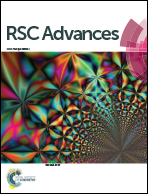Coupling interaction of cathodic reduction and microbial metabolism in aerobic biocathode of microbial fuel cell†
Abstract
Certain mixed consortia colonized on aerobic biocathodes can improve the 4-electron oxygen reduction of cathodes; however, the coupling interaction of the cathodic reaction and microbial metabolism remains unclear. To better understand the abovementioned interaction evolved in the cathodic process, biocathodes were enriched using nitrifying sludge and operated at various NH4Cl and NaHCO3 concentrations in both the open and closed external circuit conditions. Based on the variation of the nitrification and cathodic oxygen reduction activities, it was shown that the oxygen reduction process, to some extent, relied on the nitrification activity of the biocathode; the external electrons from the cathode, in turn, might benefit the nitrifying bacteria selected in the MFC habitat by entering the electron transfer chains as the energy source. Nitrifiers, including Nitrosomonas sp., Nitrospira sp. and Nitrobacter sp., were detected in all the biocathodes that were cultured in different conditions, even the ones cultured without NH4Cl in the medium. These findings provided valuable insights into the possible working mechanism of biocathodes.


 Please wait while we load your content...
Please wait while we load your content...